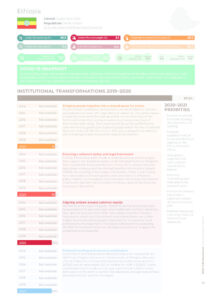Nutrition situation
Under five stunting (%)
36.8
Under five overweight (%)
2.1
Anaemia in women 15-49 years (%)
23.4
Under five wasting (%)
7.2
Low birth weight (%)
n.a.
0 to 5-month-old exclusive breastfeeding (%)
58.8
Adolescent overweight (%)
Male: 4.3
/ Female: 11.9
Adult overweight (%)
Male: 13.4
/ Female: 28
Adult obesity (%)
Male: 2
/ Female: 6.9
Adult diabetes (%)
Male: 5.8
/ Female: 5
COVID-19 snapshot
In April 2020 a state of emergency was declared, adding to other emergencies of flooding and locusts. Regional multistakeholder platforms have been initiated in almost all regions and started to work well. Government still engaged in coordinated action to maintain essential health service delivery.
Institutional transformations 2019-2020
Bringing people together into a shared space for action
Multisectoral coordination mechanisms are established at national and subnational level with clear terms of reference. The performance is regularly monitored through quarterly review meetings of the Technical Committee and biannual/annual review meetings of the Coordination Body. The Coordination Body has reaffirmed its commitment by guiding and assuring approval of the New Food and Nutrition Policy for the first time in Ethiopia. A programme delivery unit is helping to take forward the Seqota Declaration.Ensuring a coherent policy and legal framework
Fruitful efforts have been made to endorse policies and strategies that support the implementation of the National Nutrition Program. This includes the Food and Nutrition Policy, the nutrition-sensitive agriculture strategy and the Unified Nutrition Information System (UNISE) for tracking of the Seqota Declaration. There is still a need for more analysis of existing policy and use of data to influence policy makers. Such analyses have now been started by the National Information Platform for Nutrition in Ethiopia and will facilitate the necessary information.Aligning actions around common results
The National Nutrition Program II (NNP II) and Seqota Declaration have enabled the sectors to plan and implement nutrition-sensitive and -specific interventions. NNP II provided a Common Results Framework, which the Government and stakeholders can utilise to plan and to allocate adequate resources for its execution and performance management. The Seqota Declaration is catalysing the NNP II implementation but all regions need to be engaged for ownership and resources.Financial tracking and resource mobilisation
Government and stakeholders allocated resources needed for the NNP II and Seqota Declaration. Government of Ethiopia allocated USD 16 million for multisectoral Seqota Declaration interventions 2019/20 and an estimated USD 40 million for NNP II 2020/21. Some stakeholders have made a multi-year commitment which covers some parts of the NNP II. Sectors like education and agriculture have developed sector-specific strategies.2020-2021 Priorities
- Finalise Food and Nutrition Strategy development and costing.
- Endorse establishment of Food and Nutrition Agency at the Prime Minister’s Office.
- Strengthen regional food and nutrition coordination bodies.
- Enhance monitoring and evaluation and research work.
- Finalise the Seqota Declaration expansion phase design and action plan.
- Mobilise resources, including financial and technical resources.
Download

